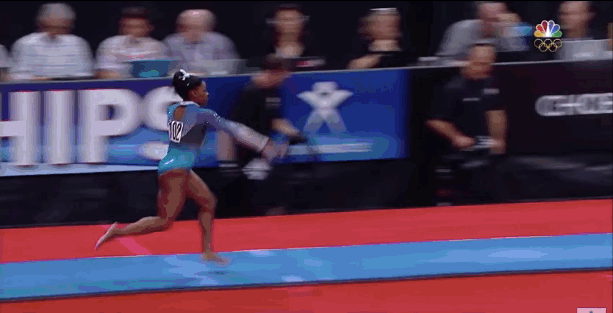Because of NBC’s policy against GIFs, we used GIFs from Biles’s and Mustafina’s recent competitions. I’ve linked video (NBC does not allow embedding) of the routines that are available online.
American gymnast Simone Biles turned the Rio Olympics’ women’s individual all-around gymnastics competition into a coronation.
“Simone is so good that the Olympics have become boring,” Dave Lease, the editor of TSL, a figure skating and gymnastics news website, told me.
Biles scored a 62.198 and won the gold medal event by more than two points — a large margin in gymnastics, where a tenth or hundredth of a point can be all that separates silver and gold. Biles’s teammate Aly Raisman nabbed the silver with a 60.098, and Russia’s Aliya Mustafina won the bronze with a 58.665.
The win gave Biles her second gold medal of these Olympics, and secured her place in the pantheon of the greatest gymnasts that the sport has ever seen. Here’s how it happened:
The competition was dramatic for about 10 minutes
For a fraction of the competition, fans saw something very rare: Simone Biles in second place.
Biles’s group — which included Raisman and Mustafina — began their gymnastics rotation on vault and then transitioned to the uneven bars for their second event. Vault is a strength for Raisman and Biles, and a weak one for Mustafina.
The Americans perform a difficult vault called the Amanar (see Biles do it in the GIF below) that’s worth a lot of points, while Mustafina and many other competitors perform a less difficult vault worth fewer points.

Biles scored a 15.866 on the vault (watch Biles’s vault at NBC), Raisman scored a 15.633, and Mustafina scored a 15.200.
But after they performed on the bars, their respective standings shifted.
Biles and Raisman struggle with the bars because the event doesn’t necessarily reward explosiveness as much as it does finesse, fluidity, and timing. It’s an event that tends to favor leaner, smaller gymnasts (look at the difference in build between Biles and her bars specialist teammate Madison Kocian).
The bars are Mustafina’s strongest event.
Judges are looking for form — straight lines, pointed toes, vertical handstands — as well as the ability to connect skills smoothly and make it look effortless. Here’s Mustafina using those skills in London four years ago, when she won the gold medal on the event:

Biles isn’t bad on the bars. But they’ve given her problems before:

There were no major bobbles on Biles’s part, and she scored a 14.966 (watch Biles’s bar routine at NBC). But Mustafina hit a clean routine with a good landing, scoring a 15.666. With one great performance, Mustafina closed the gap between her and the Americans, and briefly took the lead.
Heading into the balance beam, Mustafina was in the lead, with a 30.866 to Biles’s 30.832.
The competition effectively ended when Simone Biles got on the beam
There is no event that showcases Simone Biles’s physical gifts better than the floor routine. The apparatus lets you appreciate just how strong she is, how seemingly limitless her endurance is; she performs her third tumbling pass better and with more height than most of her competitors perform their first.
But in the 2016 Olympic women’s all-around finals it was another event, the balance beam, that proved how talented Biles is and showcased the gifts you may not notice during one of her trademark high-flying tumbling passes.
In second place, and first in the queue to perform, Biles showed why she’s a world champion on the event and also flashed her mental toughness — the reason she hasn’t lost a single all-around competition in her senior career.
Biles’s beam routine is considered world class because of the number of elements she does in succession. When she’s at her best, she’s connecting skills one after another like this:

Biles scored a commanding 15.433 on the beam after nailing her dismount (watch Biles’s beam routine at NBC), a full-twisting double back. Raisman scored a 14.866. Mustafina faltered and scored a 13.866. After three rotations, and heading into her best event — the floor — Biles was sitting at 46.265, with Mustafina at 44.666.
Biles’s floor exercise confirmed what we knew

“She [Mustafina] should be very happy with herself,” Lease said about Mustafina’s short-lived lead over Biles. “I think Aliya was in first for about 10 minutes. There was definitely a full commercial break where she was in the lead before Simone went on beam. We can’t forget they had to walk around the arena to change apparatus as well. It was maybe even 12 minutes.”
By the time Biles’s group began its final event, gold was as good as hers. Thanks to Biles’s high starting values (as determined by the difficulty in her routine), there was no way for Mustafina to catch her. Meanwhile, Raisman, who didn’t score that well on bars (14.166), was still trying to make up the ground she lost.
When the dust settled, Biles needed somewhere in the neighborhood of 13 points to win gold. To score that low (at least for her), Biles would need to step out bounds maybe twice, or to forget which tumbling pass she was doing. But there was no nonsense. Biles scored a 15.933, and cemented her place as one of the best and the most dominating female gymnasts the sport will see.



